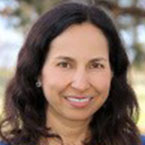Extreme heat and air pollution affect everyone, but especially children.
Children's bodies and behaviors are different from adults. These differences mean kids are at higher risk of health problems from heat and air pollution. And they will be exposed to even more health issues unless we address climate change.
Air pollution comes from driving and transportation, industry, agriculture, wildfires and human activities that rely on burning fossil fuels for energy. These activities also create heat-trapping greenhouse gases, a main cause of climate change.
Read on to learn about solutions to protect kids from health problems caused by heat and air pollution.
3 reasons pollution and heat cause more health problems for children
Children spend more time outdoors. They play, exercise and work
outside, especially in the summer. Spending time outdoors is good for growing kids, but it increases their risk of heat-related illness.
Children are growing and developing. They breathe faster and breathe more air compared to their body weight than adults. Children breathe lower to the ground where some pollution settles.
Kids depend on others. Children cannot change their surroundings to get away from extreme heat and pollution. Young children cannot even change their clothes to avoid extreme heat. Infants are especially at risk. They cannot control their environment or take in fluids without help from others.
Does climate change affect some children more than others?
Yes. For decades, some children, families and communities have faced much higher health risks from climate change. This is a result of "redlining," a historically racist policy of discrimination that began in the 1930s. Families in these
communities still live with the health effects of redlining.
Children of color are more likely to live in these neighborhoods. They are exposed to more pollution, heat-trapping asphalt and higher temperatures than those who live in surrounding areas. These families also are less likely to be able to access resources to cope with these climate problems.
What health problems are caused by heat and air pollution?
When children are exposed to dangerous heat waves and longer, hotter summers, they are at risk because:
Extra heat and sunlight create ground-level ozone, which causes asthma.
Heat can worsen local air pollution by contributing to smog.
Prolonged warm seasons and more carbon dioxide in the air lead to a longer, more intense pollen allergy season.
More intense and frequent droughts create more dust in the air and affect water supplies that people use to stay cool in the extreme heat.
More
wildfires make air pollution worse.
Air pollution & asthma
Air pollution can cause severe problems like asthma flare-ups and breathing trouble. It is linked to more emergency room visits for respiratory symptoms and missed school. With increasing and more intense pollen seasons, children with allergies or allergy-induced asthma may have symptoms earlier in the year or more severe symptoms. Lasting exposure to air pollution increases a child's risk of developing chronic illnesses like asthma, high blood pressure, cancer and mental health disorders that affect learning, memory, thinking and problem solving.
Heat-related illness
Heat can cause mild heat cramps or
heat stroke, which can be fatal. Heat exposure in young children can affect their ability to learn and concentrate. It also affects pregnancy and is linked to preterm birth and low birth weight. Some children, like those in homes without cooling systems and children on common medications, such as some ADHD medications, allergy medications, or diuretics ("water pills") are at greater risk.
How can I protect my child from heat and pollution?
Check your local Air Quality Index (AQI). Adjust your child's outdoor activities when needed.
Ask your pediatrician how air pollution can be added to your child's asthma action plan.
If your child is sensitive to allergies, monitor the local pollen index (you can search for your area here:
https://pollen.aaaai.org).
Find out what your school's guidelines are around heat and outdoor play.
On hot days, make sure your child dresses appropriately, takes breaks, drinks plenty of water, and takes time to get used to the temperature.
If your child takes medication, ask your pediatrician if it increases your child's risk for heat illness.
Use high efficiency filters in your home's central heating and cooling system.
Consider zero-emission vehicles and use public transportation or choose
walking and biking when it is safe to do so.
Promote green space and plant trees to reduce urban heat effect and clean the air.
Remember
If you have questions about your child's risk from heat and pollution, talk to your pediatrician. You can also get involved with planning in your community to support policies to reduce emissions and improve air quality for children and families from all backgrounds.
More information
About the authors
 Sheela Mahnke, MD, FAAP, is a general pediatrician at a non-profit clinic, Every Child Pediatrics, in Denver, Colo. She has a passion for environmental health issues, particularly climate change, clean air and environmental justice. She is a member of the American Academy of Pediatrics (AAP) Council on Environmental Health and Climate Change and the AAP Colorado Chapter. Sheela Mahnke, MD, FAAP, is a general pediatrician at a non-profit clinic, Every Child Pediatrics, in Denver, Colo. She has a passion for environmental health issues, particularly climate change, clean air and environmental justice. She is a member of the American Academy of Pediatrics (AAP) Council on Environmental Health and Climate Change and the AAP Colorado Chapter.
|
 Pragya Rai, MD, FAAP, is a pediatric pulmonologist at Sacred Heart Children's Hospital in Spokane, WA. She was a Climate and Health Equity Fellow for 2022 of The Medical Society Consortium on Climate and Health. She is a certified Climate for Health ambassador, member of the Washington Pediatricians for Climate Action, and a steering committee member of 350 Spokane. Pragya Rai, MD, FAAP, is a pediatric pulmonologist at Sacred Heart Children's Hospital in Spokane, WA. She was a Climate and Health Equity Fellow for 2022 of The Medical Society Consortium on Climate and Health. She is a certified Climate for Health ambassador, member of the Washington Pediatricians for Climate Action, and a steering committee member of 350 Spokane.
|
 Elizabeth Friedman, MD, MPH, FAAP, is the medical director of the environmental health program and physician at Children's Mercy, Kansas City, Mo. She is director of Pediatric Environmental Health Specialty Unit Region 7 and assistant professor at University of Missouri, Kansas City School of Medicine. She is a member of the Medical Society Consortium on Climate and Health steering committee, co-chair of the Academic Pediatric Association Environmental Health, Climate Change and Sustainability Special Interest Group and a co-founder of the Missouri Clinicians for Climate Action. Elizabeth Friedman, MD, MPH, FAAP, is the medical director of the environmental health program and physician at Children's Mercy, Kansas City, Mo. She is director of Pediatric Environmental Health Specialty Unit Region 7 and assistant professor at University of Missouri, Kansas City School of Medicine. She is a member of the Medical Society Consortium on Climate and Health steering committee, co-chair of the Academic Pediatric Association Environmental Health, Climate Change and Sustainability Special Interest Group and a co-founder of the Missouri Clinicians for Climate Action.
|
This document was supported in part through cooperative agreement OT18-1802 awarded to the American Academy of Pediatrics and funded by the Centers for Disease Control and Prevention’s National Center for Environmental Health and the Agency for Toxic Substances and Disease Registry. The contents of this publication are solely the responsibility of the authors and do not necessarily represent the official views of the Centers for Disease Control and Prevention or the U.S. Department of Health and Human Services.